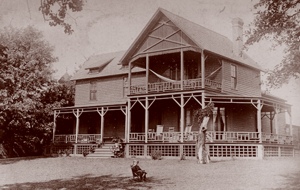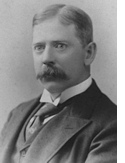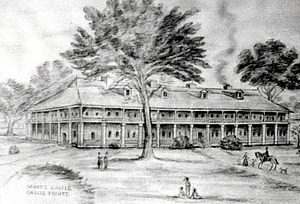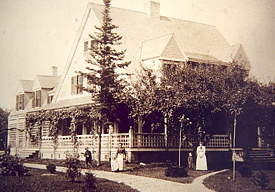|
 The new and pretty cottage of Henry Russel adjoins Mr. Newland's residence, and is called "Weeanne." Mr. Russel is attorney for the Michigan Central Railway, an evidence that he is one of the brightest and most talented young lawyers of Detroit. The arduous duties of his profession do not prevent him from being foremost in every scheme calculated to add to the social pleasures of the colony. He married Nellie Hogarth Muir, a daughter of W. K. Muir. They have two children, Christine Muir and Anna Davenport. The new and pretty cottage of Henry Russel adjoins Mr. Newland's residence, and is called "Weeanne." Mr. Russel is attorney for the Michigan Central Railway, an evidence that he is one of the brightest and most talented young lawyers of Detroit. The arduous duties of his profession do not prevent him from being foremost in every scheme calculated to add to the social pleasures of the colony. He married Nellie Hogarth Muir, a daughter of W. K. Muir. They have two children, Christine Muir and Anna Davenport.
 Passing the Catholic Church and the Convent of the Sacred Heart, which are elsewhere described, we come to Rest Cottage, the residence of Dr. Morse Stewart, who divides with few the honor of being at the head of the medical profession in Detroit. The doctor and his family are to be classed among the old residents at the Pointe, but of late they have leased their residence. Mrs. Stewart's maiden name was Isabella Graham Bethune Duffield. She is the daughter of Rev. George Duffield, D. D., who, previous to his decease, was one of the best known Presbyterian clergymen of the West. Mrs. Stewart has rare conversational gifts, and is prominent and successful in many philanthropic enterprises. Passing the Catholic Church and the Convent of the Sacred Heart, which are elsewhere described, we come to Rest Cottage, the residence of Dr. Morse Stewart, who divides with few the honor of being at the head of the medical profession in Detroit. The doctor and his family are to be classed among the old residents at the Pointe, but of late they have leased their residence. Mrs. Stewart's maiden name was Isabella Graham Bethune Duffield. She is the daughter of Rev. George Duffield, D. D., who, previous to his decease, was one of the best known Presbyterian clergymen of the West. Mrs. Stewart has rare conversational gifts, and is prominent and successful in many philanthropic enterprises.
Separated from the Stewart place by the Moran Road, is the Grant Farm, more recently known as the George Moran Farm. This farm is noted as embracing the first "cleared" land in Grosse Pointe. It originally extended from the present Catholic Church property to the grounds of G. V. N. Lothrop. It had a frontage of nine arpents (French acres), and contained about 400 acres. It was first cultivated by Commodore Alexander Grant, a British naval officer, in command of several men-of-war when this part of the country was in English possession. Aspiring to found a seigneury similar to the old French claims on the St. Lawrence, he selected this tract of land, and during the winter, when the lakes were frozen, he employed his sailors and soldiers in clearing off the forest trees. Soon after acquiring the title, he erected a large manor-house, known in its day as "Grant's Castle." It was built of hewn oaken timbers taken from the surrounding forest. These were neatly dovetailed at the corners, and the interstices between the logs carefully filled with plaster. It was about 160 feet long, two stories in height, and surrounded on all sides by huge two story verandas or "galleries," as the French termed them, and, in shape, resembled a great barrack.  The Commodore may, on this showing, be justly termed the founder of Grosse Pointe, and, to make proper explanation here, might result in his being confounded a hundred years hence, with one Ulysses, who, when a young lieutenant, resided for a time in Detroit, and who, it is authoritatively said, enjoyed the French pony racing, and appreciated the fine flavor of the liqueur de pêche as much as did the old Commodore. The Commodore may, on this showing, be justly termed the founder of Grosse Pointe, and, to make proper explanation here, might result in his being confounded a hundred years hence, with one Ulysses, who, when a young lieutenant, resided for a time in Detroit, and who, it is authoritatively said, enjoyed the French pony racing, and appreciated the fine flavor of the liqueur de pêche as much as did the old Commodore.
The Commodore was one of the Clan Grant of Glenmoriston, Invernesshire, and entered the navy of his majesty, George II, at an early age, but left the service in 1757 and joined a Highland regiment, raised for the army of General Amherst, which army reached Lake Champlain in 1759, en route to capture Canada from the French. The General, requiring officers for his fleet on the lake, commissioned Lieutenant Grant as the commander of a sloop of sixteen guns. The operations of the combined forces under General Amherst having secured the conquest of Canada, Grant was sent to Lakes Ontario and Erie. In 1774, he married Therese, daughter of Charles Barthe, of Detroit. The family are descended from Theophile Barthe (armorer to the King) who was married at Montreal in 1718 to Charlotte Alavoine. Adelaide Askin, wife of Col. Elijah Brush and mother of Hon. Edmund A. Brush, was of the same family, through her mother, Marie Archange Barthe. The Barthe family are also connected with the Godfroys, Navarres, the Descomptes Labadies (ancestors of Mrs. Richard Storrs Willis, of Detroit), and many others equally well known.
At the time of Commodore Grant's marriage, Detroit and vicinity were part of Canada, and from his castle at the Pointe, he used to distribute British bounties and pensions to the savage allies of King George. The great chief Tecumseh and others of his tribe were frequent visitors at "Grant's Castle." The Commodore was called to the executive council in 1805, and administered the government of Upper Canada. He was a man of commanding presence, a good officer, and a general favorite. In a letter to his brother at York (now Toronto), written in 1811, he says, "My duty where my naval command requires me, is at such a distance, that I cannot travel in the winter, but I come down at my ease in summer to take some sittings in Council. A gentleman who has served his country for fifty years requires some indulgence, and my superiors allow it to me."
He died at Grosse Pointe in 1813, leaving eleven daughters and one son, a British officer who resided at Brockville, Canada. Of the descendants of the daughters, some reside in Canada, and others have gone to the old country. Among the former are the families of the Wrights, Robinsons, Dicksons, Woods, Duffs, Wilkinsons, Millers, Jacobs, and Richardsons. Of the Barthe family, an older sister of Mrs. Grant married John Askin, from whom spring the Essex County family of the name, daughters of whom became mothers of the Hamiltons, Richardsons, Merediths, McKees, Pattersons, Brushes, and Ronalds. Another sister of Mrs. Grant married Major Mercer of the Royal Artillery, one of whose daughters has achieved some literary fame and is still living in England.
The Grants also had an adopted child, a boy who had been taken prisoner by the Indians, but was rescued from an untimely fate through Mrs. Grant's interposition. This boy, called John Grant, was given a farm of 300 acres, a short distance above the first settlement. This farm is now owned by T. P. Hall. The old Grant houses on both farms were recently demolished.
 George Moran, who succeeded to the Grant farm, died in 1882. He settled here at an early day, and was a noted character of old Grosse Pointe. As a reconteur he was a decided success, and many of his humorous stories are still related. On Indian fights and all the startling events of the mystic past, he was considered an authority. At his death he had disposed of a large portion of his farm, but several of his children still retain portions of the ancestral homestead. His oldest son, Richard Moran, resides on the rear of the farm, and is well versed in the history of the Pointe. Another son, Charles G. Moran, owns the cottage on the front of the farm next to the Moran Road. The latter was the first President of Grosse Pointe village, and is now one of the auditors of Wayne county. He married a daughter of Richard Conner. Louis and James are two other sons of George Moran. George Moran, who succeeded to the Grant farm, died in 1882. He settled here at an early day, and was a noted character of old Grosse Pointe. As a reconteur he was a decided success, and many of his humorous stories are still related. On Indian fights and all the startling events of the mystic past, he was considered an authority. At his death he had disposed of a large portion of his farm, but several of his children still retain portions of the ancestral homestead. His oldest son, Richard Moran, resides on the rear of the farm, and is well versed in the history of the Pointe. Another son, Charles G. Moran, owns the cottage on the front of the farm next to the Moran Road. The latter was the first President of Grosse Pointe village, and is now one of the auditors of Wayne county. He married a daughter of Richard Conner. Louis and James are two other sons of George Moran.
|